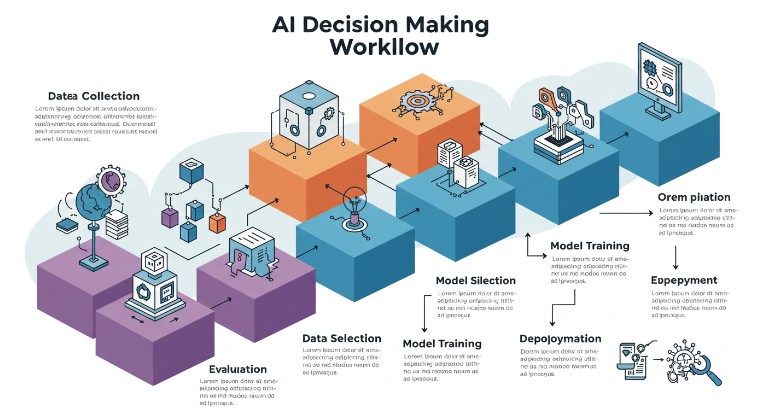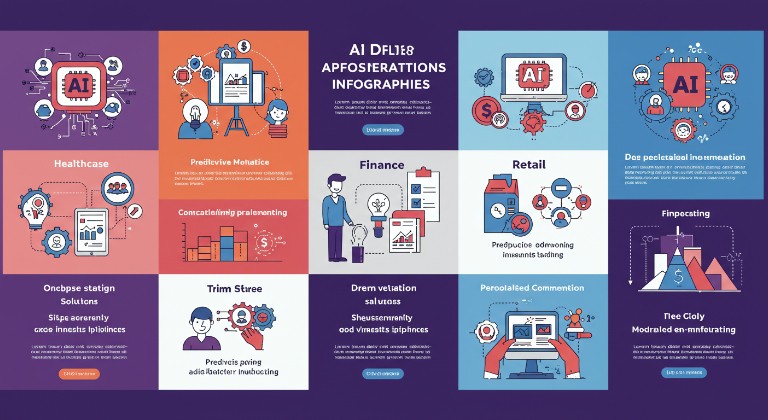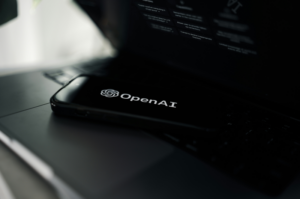Introduction
Imagine a world where business decisions aren’t just guesses or gut feelings but carefully calculated strategies backed by real-time data and cutting-edge technology. Welcome to 2025—a time when Artificial Intelligence (AI) is transforming how businesses operate, compete, and thrive. Whether you’re running a small coffee shop or managing a multinational corporation, AI is no longer a luxury; it’s a necessity. It’s like having an extra brain on your team, one that never gets tired and is always up-to-date with the latest trends. Let’s dive into how AI is revolutionizing business decision-making and why it’s the secret sauce to staying ahead in the game.
Table of Contents
What is the Role of AI in Business Decision-Making in 2025?
In today’s fast-paced business environment, decisions need to be made faster, smarter, and with greater accuracy. AI plays a pivotal role by processing vast amounts of data, identifying patterns, and providing actionable insights that humans might miss. Think of AI as your 24/7 decision-making partner that never sleeps and always delivers.
Key Benefits:
- Enhanced Accuracy: AI reduces errors by analyzing historical and real-time data with precision that’s simply unmatched by manual processes.
- Speed: Decisions that once took days can now be made in minutes, giving businesses a competitive edge.
- Scalability: AI tools can handle massive datasets, making them ideal for both startups and large enterprises looking to expand their reach and capabilities.
AI isn’t just a tool; it’s a transformational force that reshapes how businesses think and act.

How Does AI Improve the Accuracy and Speed of Decision-Making Processes?
AI uses machine learning (ML) and predictive analytics to predict outcomes and recommend optimal courses of action. For example, AI can analyze market trends to forecast demand for a product, helping businesses avoid overproduction or stock shortages. It’s like having a crystal ball, only much smarter and more reliable.
Comparison: Traditional vs. AI-Augmented Decision-Making
| Feature | Traditional Decision-Making | AI-Augmented Decision-Making |
|---|---|---|
| Speed | Slow | Rapid |
| Data Utilization | Limited | Extensive |
| Error Rate | Higher | Lower |
| Adaptability | Limited | High |
The ability to adapt to real-time data changes means businesses using AI are better positioned to respond to challenges and seize opportunities.
What Are the Most Common AI Tools Used for Business Analytics and Decision-Making?
Here’s a list of top AI-powered tools that businesses are leveraging:
- Tableau with Einstein Analytics: Advanced data visualization and predictive analytics.
- Power BI: Real-time data insights and forecasting, perfect for cross-departmental collaboration.
- Mindbreeze InSpire: Faster strategic decisions via complex data analysis tailored for enterprise needs.
- HubSpot CRM: Predictive sales analytics and customer behavior insights, boosting marketing ROI.
- Otter.ai: Meeting transcriptions and summaries for better collaboration and record-keeping.
These tools don’t just crunch numbers; they tell a story with your data, making it easier to understand and act on.
| AI Tool | Key Features |
|---|---|
| Tableau with Einstein Analytics | Advanced data visualization and predictive analytics. |
| Power BI | Real-time data insights and forecasting, great for cross-departmental collaboration. |
| Mindbreeze InSpire | Complex data analysis tailored for enterprise decision-making. |
| HubSpot CRM | Predictive sales analytics and customer behavior insights. |
| Otter.ai | Meeting transcription and summary generation for collaboration and record-keeping. |
How Can Small Businesses Leverage AI to Enhance Their Strategic Decisions?
AI isn’t just for tech giants. Small businesses can use affordable and user-friendly AI tools to streamline operations and improve decision-making. For instance:
- Automation: Tools like Zapier save time on repetitive tasks, freeing up resources for innovation.
- Customer Insights: HubSpot CRM provides personalized marketing insights that help retain loyal customers.
- Content Creation: Jasper helps craft tailored marketing campaigns, giving smaller teams a creative edge.
Anecdote:
Imagine you own a small bakery. By using predictive analytics, you can forecast which pastries will sell best on specific days, reducing waste and boosting profits. AI makes it possible—and easy! With tools like these, small businesses can punch well above their weight class.
What Industries Are Seeing the Most Significant Impact from AI-Driven Decision-Making?
AI is leaving its mark across various sectors:
- Healthcare: Predictive modeling for patient care enables personalized treatment plans.
- Retail: Personalized marketing and inventory management improve customer satisfaction and reduce waste.
- Finance: Risk assessment tools and fraud detection provide a new level of security and foresight.
- Manufacturing: Autonomous decision systems optimize supply chains and production schedules.
AI doesn’t just improve efficiency; it redefines what’s possible in these industries, driving innovation and growth.

Ethical Concerns: What Are the Risks of Using AI in Business Decisions?
AI isn’t without its challenges. Ethical concerns include:
- Bias: AI can perpetuate existing biases in data, leading to unfair or discriminatory decisions.
- Privacy: Handling sensitive customer information responsibly is more crucial than ever.
- Transparency: Ensuring decisions are explainable and fair builds trust with stakeholders and customers alike.
Businesses must adopt AI with a strong focus on ethics and compliance to build trust with stakeholders. Investing in causal AI models, which provide clear cause-and-effect insights, can help mitigate some of these issues.
How Does Predictive Analytics Powered by AI Help Businesses Forecast Trends?
Predictive analytics uses historical data to predict future outcomes. For example:
- Retailers can anticipate shopping trends to optimize inventory and avoid costly overstocking.
- Marketers can tailor campaigns based on customer sentiment analysis, boosting engagement and conversion rates.
- Supply Chain Managers can foresee disruptions and adjust logistics in advance, maintaining seamless operations.
This proactive approach enables businesses to stay ahead of market changes and make informed decisions that maximize profitability.
| Use Case | Description |
|---|---|
| Demand Forecasting | Predicts customer demand patterns to optimize inventory and reduce waste. |
| Customer Segmentation | Identifies distinct customer groups for tailored marketing strategies. |
| Financial Risk Assessment | Analyzes market conditions to minimize financial risks and enhance stability. |
| Supply Chain Optimization | Anticipates disruptions and ensures seamless logistics. |
| Employee Turnover Prediction | Identifies factors contributing to employee attrition for proactive retention. |
How to Integrate AI Into Existing Workflows?
- Start Small: Implement AI in one department (e.g., marketing or sales) and expand as you see measurable results.
- Train Employees: Educate staff on AI tools and their benefits, fostering a culture of innovation.
- Choose Scalable Tools: Opt for platforms like Power BI or Zapier that grow with your business and integrate seamlessly with existing systems.
Integration doesn’t have to be daunting—start simple and expand as you see results. Focus on clear ROI and employee buy-in to ensure a smooth transition.
Conclusion
AI is more than a buzzword; it’s a game-changer. By harnessing AI, businesses can make smarter, faster, and more informed decisions. Whether you’re a small business owner or a corporate executive, the time to embrace AI is now. The possibilities are endless—and the tools are more accessible than ever.
Call-to-Action: Ready to transform your decision-making process? Explore top AI tools like Tableau, Power BI, or HubSpot CRM to get started today!




